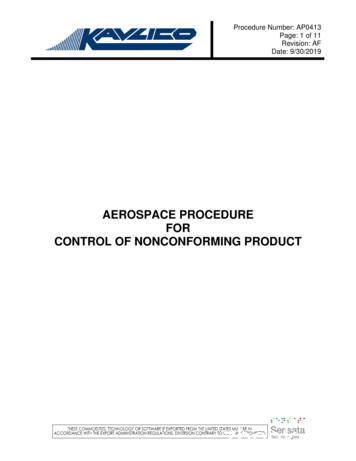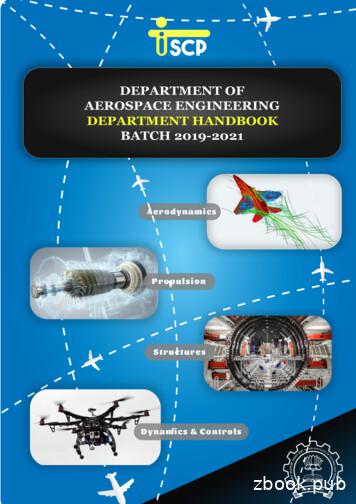School Of Aerospace Engineering AE/ME 6766 Combustion .
School of Aerospace EngineeringAE/ME 6766 Combustion:IntroductionJerry Seitzman250020000.151500CH4H2OHCO x 1000Temperature0.110000.05500Temperature (K)Mole Fraction0.2Methane Flame0000.10.20.3Distance (cm)Introduction -1Copyright 2004-2005, 2020-2021 by Jerry M. Seitzman. All rights reserved.AE/ME 6766 CombustionSchool of Aerospace EngineeringImportance of Combustion Chemical energy conversion by combustion to usefulwork/heat is significant energy source ( 80% in U.S. 2019) Many applications– propulsion: ground, air, marine, space (high power density)– power generation: natural gas/coal/oil/biomass boilers, lowemissions gas turbines– heating systems: water, space heating, district heating (e.g.,GT steam plant), food processing– industrial processes: manufacture of cement, glass, paper,metal, carbon black; drying; materials/chemical processing– energetic materials: fireworks, demolition, munitions– fire safety: ignition, flame spread, smoke generation– incineration: waste, toxic materials Related technologies: fuel cells, catalytic (low T) combustionIntroduction -2Copyright 2004-2005, 2020-2021 by Jerry M. Seitzman. All rights reserved.AE/ME 6766 Combustion1
School of Aerospace EngineeringEngineering Issues in Combustion Efficiency (chemical-thermal energy conversion)– typically high, 98-99% Environmental impacts– pollutants: NOx, SOx, CO, soot (PM2.5), UHC, – global climate: CO2, H2O, particulates (cloud formation) cleaner and sustainable fuels (syngas, biofuels, H2) Stability– static (flame stability): flame loss, blowout– dynamic: acoustic-heat release coupling, combustion dynamics Volumetric efficiency (especially for propulsion systems)– size/weight of combustor (residence time limitations) Heat loading distribution– combustor walls; heat exchange surfaces (boilers, “crackers”, ) Safety (flammability, explosions, detonations, )AE/ME 6766 CombustionIntroduction -3Copyright 2004-2005, 2020-2021 by Jerry M. Seitzman. All rights reserved.School of Aerospace EngineeringWhat is Combustion? Self-sustained “oxidation” of a fuel– fuel typically a hydrocarbon– oxidizer typically airThermodynamicsMaterials ScienceChemicalKineticsIntroduction -4Copyright 2004-2005, 2020-2021 by Jerry M. Seitzman. All rights reserved.Combustion TransferCombustionScience &TechnologyComputer ModelingControlsFluidMechanicsAE/ME 6766 Combustion2
School of Aerospace EngineeringLearning ObjectivesTo provide fluency in:1. Modeling rates of chemical reaction processes2. Reduced-order modelling of combustion processesbased on coupled chemical-thermal analysis (reactors)3. Conservation/transport equations for reacting flows4. Structure and propagation limits of laminar premixedcombustion waves5. Structure and controlling processes in laminar nonpremixed (diffusion) flames6. Time and spatial scales in turbulent flames, and basicissues in turbulent combustionIntroduction -5Copyright 2004-2005, 2020-2021 by Jerry M. Seitzman. All rights reserved.AE/ME 6766 CombustionSchool of Aerospace EngineeringOverview of Topical Outline Review– chemical thermodynamics: equilibrium changes incomposition, temperature, pressure– gas kinetic theory: collision rates Chemical kinetics– extend kinetic theory to rates of chemical reactions– reaction mechanisms (set of reactions) Coupled chemical/thermal modeling– chemical reactors that use highly simplified fluidmechanic assumptions (e.g., no diffusion/mixing orinfinite mixing rates) Generalized conservation/transport equationsIntroduction -6Copyright 2004-2005, 2020-2021 by Jerry M. Seitzman. All rights reserved.AE/ME 6766 Combustion3
School of Aerospace EngineeringOverview of Topical Outline (con’t) Premixed laminar combustion– structure of supersonic (detonations) and subsonic(flames) combustion driven waves– propagation: flame speeds, flammability limits,quenching, stretch,– ignition Nonpremixed laminar combustion– diffusion-limited flames: jets and burning droplets– finite rate chemistry effects vs. fluid/evap. times Turbulent flames– time and spatial scales– premixed and nonpremixed combustionIntroduction -7Copyright 2004-2005, 2020-2021 by Jerry M. Seitzman. All rights reserved.AE/ME 6766 CombustionSchool of Aerospace EngineeringCourse Syllabus Complete syllabus available on Canvas and classweb page (seitzman.gatech.edu/classes/ae6766) Learning exercises and assessments––––homeworkprojects (with formal reports)midterm exams (2)final exam Collaboration– acceptable to discuss homework/projects with otherstudents (or colleagues)– copying (even with attribution) unacceptableIntroduction -8Copyright 2004-2005, 2020-2021 by Jerry M. Seitzman. All rights reserved.AE/ME 6766 Combustion4
School of Aerospace EngineeringResources Class web site– seitzman.gatech.edu/classes/ae6766– this link also available on Canvas Textbook– Stephen Turns, An Introduction to Combustion: Conceptsand Applications, 3rd edition Additional texts– Irvin Glassman, Combustion, 3rd edition– C.K. Law, Combustion Physics– Bernard Lewis and Guenther von Elbe, Combustion, Flamesand Explosions in Gases– Forman Williams, Combustion Theory, 2nd edition– Kenneth Kuo, Principles of Combustion– Roger Strehlow, Fundamentals of CombustionIntroduction -9Copyright 2004-2005, 2020-2021 by Jerry M. Seitzman. All rights reserved.AE/ME 6766 Combustion5
–Stephen Turns, An Introduction to Combustion: Concepts and Applications, 3rd edition Additional texts –Irvin Glassman, Combustion, 3rd edition –C.K. Law, Combustion Physics –Bernard Lewis and Guenther von Elbe,
Grade Level/4-H Experince Pre-Flight (1) Aerospace Lift-Off (2) Aerospace Reaching New Heigts (3) Aerospace Pilot in Command (4) Aerospace Flight Crew Aerospace Leaders Launching Youth Aerospace Programs Aerospace Leaders Gifts of Gold: Seeds, Stalks, & Science Agriculture Gifts of Gold: Food
The Department of Mechanical, Aerospace and Nuclear Engineering (MANE), is part of Rensselaer's School of Engineering (SOE). MANE offers three collaborative but distinct undergraduate programs leading to a Bachelor of Science degree: Mechanical Engineering (ME), Aerospace Engineering (AE), and Nuclear Engineering (NE).
AAEF2-025: Dressing aircraft engines (Aerospace and Aviation) AAEF2-017: Maintaining mechanical devices and equipment (Aerospace and Aviation) AAEF2-026: Maintaining aircraft mechanical devices and equipment (Aerospace and Aviation) AAEF2-024: General electrical and electronic engineering applications (Aerospace and Aviation)
Aerospace Retirees’ Club (- Name of Board Member -) P.O. Box 2194 El Segundo, CA 90245 Call the ARC voicemail: 310-336-5454, Box 12582 NOTICE The expressions of opinion in the Aerospace Retirees’ Club Newsletter are the opinions of the writers and not necessarily those of the Aerospace Retirees’ Club or The Aerospace Corporation.
AS9100 Aerospace Standard, SAE AS9131 Aerospace Standard, SAE, Nonconformance Documentation AQMSM1001 Aerospace Quality Management System Manual, Kavlico AP0410 Aerospace Procedure for Receiving Inspection AP0410-1 Aerospace Procedure for In-Process Inspection AP0410-2
Petroferm Inc. 3938 Porett Dr. Gurnee, IL 60031 (847) 244-3410 aerospace@petroferm.com www.petroferm.com CLEANING PRODUCTS FOR AEROSPACE & DEFENSE AEROSPACE APPROVAL LIST OEM/MRO Approvals/Test Method Conformance Honeywell Aerospace MIL AXAREL 1000 MIL -PRF 680 qualifications (Type I) AXAREL 2000
Established in 1966-1967 as the Department of Aeronautical Engineering, the department was renamed the Department of Aerospace Engineering in 1992. The department runs strong undergraduate and graduate program in Aerospace Engineering and carries ou research in several areas of Aeronautical and Aerospace Sciences.
An Aerospace Engineering aspirant must meet the minimum eligibility criteria to be able to pursue the course. Check the minimum eligibility criteria for Aerospace Engineering below: Minimum eligibility criteria for pursuing Aerospace Engineering is HSc or Class 12 pass with a minimum of 60 percent marks (55 per cent marks for SC/ST) in Science .























